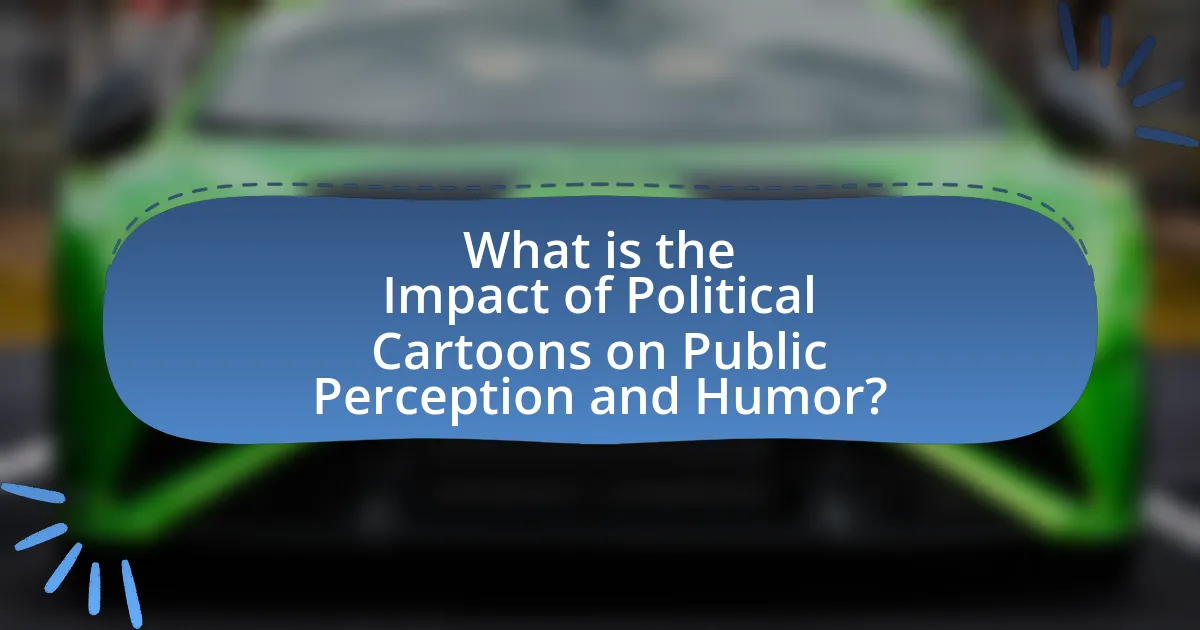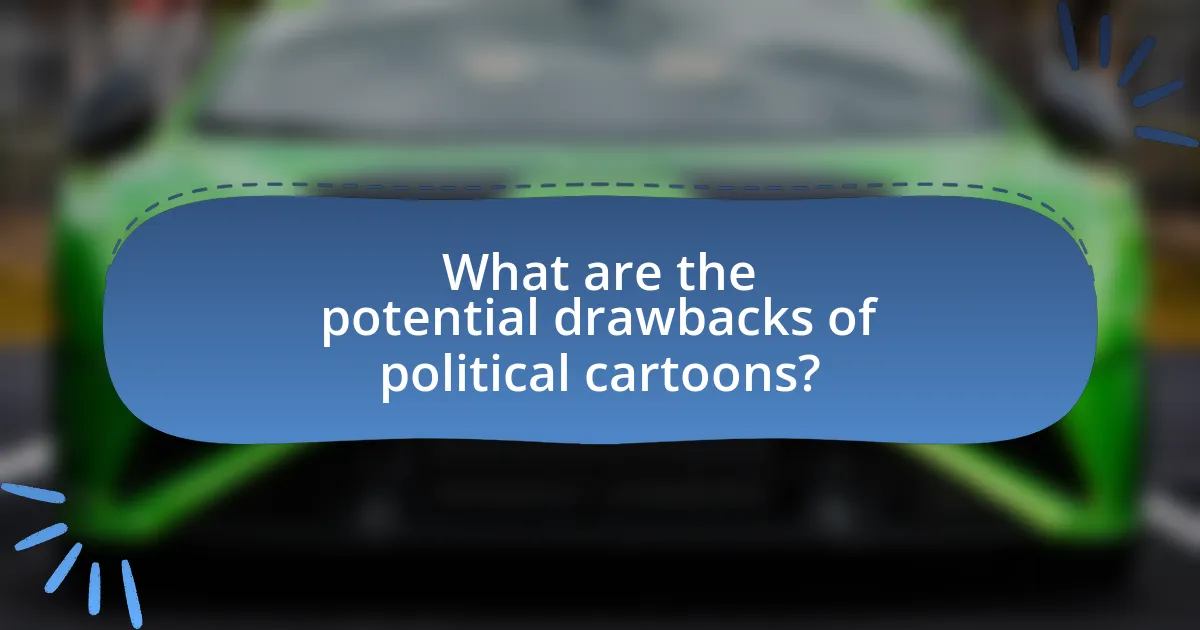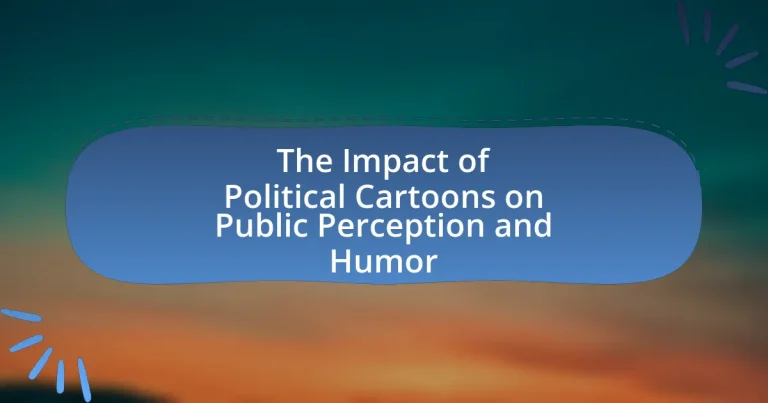Political cartoons play a significant role in shaping public perception and humor by simplifying complex political issues through satire and visual representation. They influence public opinion by evoking emotional responses and encouraging civic engagement, often using techniques such as caricature, symbolism, and exaggeration. The interpretation of these cartoons is heavily influenced by cultural contexts and demographic factors, which affect how audiences perceive humor and critique. Additionally, while political cartoons can enhance understanding of political discourse, they also have the potential to perpetuate stereotypes and misinformation. The evolution of political cartoons, driven by technological advancements and historical events, highlights their enduring impact on society.

What is the Impact of Political Cartoons on Public Perception and Humor?
Political cartoons significantly influence public perception and humor by simplifying complex political issues and making them accessible through satire. They often highlight societal problems, critique political figures, and provoke thought, which can shape public opinion and encourage civic engagement. For instance, during the 2008 U.S. presidential election, cartoons depicting candidates’ traits and policies helped voters form opinions quickly, as evidenced by studies showing that visual media can enhance understanding and retention of political messages. Additionally, the humor in political cartoons can serve as a coping mechanism for audiences, allowing them to engage with serious topics in a more lighthearted manner, thereby fostering a dialogue around critical issues.
How do political cartoons influence public opinion?
Political cartoons influence public opinion by simplifying complex political issues and presenting them in a visually engaging manner. This visual representation often evokes emotional responses, making the content more relatable and memorable for the audience. For instance, a study by the Pew Research Center found that visual media, including cartoons, significantly shape political attitudes by highlighting specific narratives and framing issues in a particular light. By using satire and humor, political cartoons can challenge prevailing views and encourage critical thinking, ultimately swaying public sentiment on various topics.
What techniques do political cartoonists use to convey messages?
Political cartoonists use techniques such as satire, caricature, symbolism, and exaggeration to convey messages effectively. Satire allows cartoonists to critique political figures and societal issues humorously, while caricature emphasizes distinctive features of individuals to highlight their traits or behaviors. Symbolism employs images or objects to represent larger concepts, making complex ideas more accessible. Exaggeration amplifies certain aspects of a situation or character to provoke thought or laughter, enhancing the overall impact of the message. These techniques have been historically significant in shaping public perception and influencing political discourse, as seen in the works of renowned cartoonists like Thomas Nast, who used these methods to address issues such as corruption and social justice in the 19th century.
How do cultural contexts affect the interpretation of political cartoons?
Cultural contexts significantly influence the interpretation of political cartoons by shaping the symbols, references, and humor that resonate with audiences. For instance, a cartoon that uses local idioms or cultural icons may be easily understood by individuals familiar with that context, while it may confuse or mislead those from different backgrounds. Research indicates that political cartoons often rely on shared cultural knowledge; for example, a cartoon referencing a national holiday or a historical event will be interpreted differently depending on the audience’s familiarity with that context. This is evident in the work of authors like Robert Hariman and John Louis Lucaites, who argue that the effectiveness of political cartoons hinges on the audience’s cultural literacy and shared experiences. Thus, cultural contexts serve as a lens through which political cartoons are both created and understood, affecting their impact on public perception and humor.
Why are political cartoons considered a form of humor?
Political cartoons are considered a form of humor because they use satire and exaggeration to critique political events and figures. This comedic approach allows artists to convey complex ideas and social commentary in a visually engaging and accessible manner. For instance, the use of caricature in political cartoons highlights the absurdities of political situations, making them relatable and entertaining to the audience. Historical examples, such as Thomas Nast’s cartoons during the 19th century, illustrate how humor can effectively influence public opinion and provoke thought about serious issues.
What role does satire play in political cartoons?
Satire serves as a critical tool in political cartoons by highlighting societal issues and political absurdities through humor and exaggeration. This form of expression allows artists to critique political figures and policies, making complex topics more accessible to the public. For instance, political cartoons often use caricatures to emphasize the flaws or contradictions in political actions, thereby fostering public discourse and encouraging critical thinking. Historical examples, such as Thomas Nast’s cartoons during the 19th century, effectively used satire to expose corruption in politics, influencing public opinion and leading to significant reforms.
How do political cartoons balance humor and serious commentary?
Political cartoons balance humor and serious commentary by using satire to highlight social and political issues while engaging the audience. The humor often serves as a vehicle to present critical viewpoints, making complex topics more accessible and stimulating discussion. For example, a cartoon may exaggerate a politician’s actions or statements, allowing viewers to recognize absurdities in real-world events, thus prompting reflection on the underlying issues. This technique effectively combines entertainment with critique, as evidenced by historical cartoons that have influenced public opinion during significant events, such as the political cartoons of Thomas Nast in the 19th century, which played a crucial role in shaping perceptions of corruption in New York City.

How have political cartoons evolved over time?
Political cartoons have evolved significantly from their origins in the 18th century to the present day, adapting to changes in technology, society, and political landscapes. Initially, these cartoons served as a means of satire and commentary on political events, often utilizing hand-drawn illustrations in print media. With the advent of lithography and later, color printing, the visual impact and accessibility of political cartoons increased, allowing them to reach broader audiences.
In the 20th century, the rise of mass media, including newspapers and magazines, further transformed political cartoons into a staple of public discourse, often reflecting and shaping public opinion on key issues. The introduction of television and the internet in the late 20th and early 21st centuries led to new formats, such as animated cartoons and digital memes, which have expanded the reach and immediacy of political commentary.
Today, political cartoons utilize social media platforms for rapid dissemination, allowing for real-time engagement with current events. This evolution reflects a shift towards more diverse perspectives and styles, as artists incorporate various cultural references and humor to resonate with global audiences. The historical context of political cartoons demonstrates their enduring role in influencing public perception and humor, adapting to the mediums and societal norms of each era.
What historical events have shaped the development of political cartoons?
The development of political cartoons has been significantly shaped by events such as the American Revolution, the French Revolution, and the rise of mass media in the 19th century. The American Revolution (1775-1783) fostered the use of cartoons as a means of political expression, exemplified by Benjamin Franklin’s “Join, or Die” cartoon, which rallied support for colonial unity against British rule. The French Revolution (1789-1799) further propelled political cartoons into prominence, as artists like James Gillray used satire to critique political figures and societal issues, influencing public opinion. Additionally, the advent of mass media, particularly with the establishment of illustrated newspapers in the mid-1800s, expanded the reach and impact of political cartoons, allowing them to shape public perception on a larger scale. These historical events collectively established political cartoons as a vital tool for political commentary and social critique.
How did early political cartoons differ from modern ones?
Early political cartoons primarily focused on satire and caricature to critique political figures and events, often using exaggerated imagery and symbolism to convey their messages. In contrast, modern political cartoons tend to incorporate a wider range of media, including digital formats, and often employ more nuanced humor, irony, and commentary on complex social issues. For example, early cartoons like those by Thomas Nast in the 19th century used clear, bold imagery to address specific political corruption, while contemporary cartoons may blend visual art with multimedia elements to engage audiences on platforms like social media, reflecting a shift in both style and distribution methods.
What technological advancements have impacted the creation of political cartoons?
Technological advancements such as digital illustration software, social media platforms, and high-speed internet have significantly impacted the creation of political cartoons. Digital illustration software like Adobe Illustrator allows artists to create detailed and polished cartoons more efficiently than traditional methods. Social media platforms enable rapid dissemination and sharing of political cartoons, increasing their reach and influence on public perception. High-speed internet facilitates access to a global audience, allowing cartoonists to engage with diverse viewpoints and respond quickly to current events. These advancements have transformed the landscape of political cartooning, making it more accessible and immediate.
Why do political cartoons resonate with audiences today?
Political cartoons resonate with audiences today because they effectively simplify complex political issues through humor and satire. This visual medium allows for immediate comprehension and engagement, making it easier for viewers to grasp nuanced topics. For instance, a 2020 study published in the Journal of Visual Communication found that political cartoons significantly enhance audience retention of political messages compared to traditional news articles. By using exaggeration and caricature, these cartoons provoke thought and discussion, fostering a deeper understanding of current events and societal issues.
What demographic factors influence the reception of political cartoons?
Demographic factors such as age, education level, political affiliation, and cultural background significantly influence the reception of political cartoons. Younger audiences may interpret humor and satire differently than older generations, often due to varying levels of exposure to political discourse. Education level affects comprehension and appreciation of the nuances in political cartoons; individuals with higher education may grasp complex themes more readily. Political affiliation plays a crucial role, as individuals often resonate more with cartoons that align with their beliefs, leading to polarized interpretations. Cultural background also shapes perspectives, as different cultures may have distinct humor styles and political contexts that affect how cartoons are perceived. Studies indicate that these demographic factors create diverse interpretations and reactions to political cartoons, highlighting the importance of understanding audience composition in media consumption.
How do social media platforms affect the spread of political cartoons?
Social media platforms significantly enhance the spread of political cartoons by facilitating rapid sharing and engagement among users. These platforms allow for immediate dissemination to a global audience, increasing visibility and reach compared to traditional media. For instance, a study by the Pew Research Center found that 69% of adults in the U.S. use social media, which serves as a primary source for news and political commentary, including political cartoons. This widespread usage enables cartoons to go viral, often leading to discussions and debates that amplify their impact on public perception and humor.

What are the potential drawbacks of political cartoons?
Political cartoons can perpetuate stereotypes and misinformation, leading to a skewed public perception. These cartoons often simplify complex political issues, which can result in misunderstandings among audiences. For instance, a study by the Pew Research Center found that visual media, including cartoons, can influence people’s opinions by reinforcing existing biases rather than encouraging critical thinking. Additionally, political cartoons may alienate certain groups, as they can be interpreted as offensive or dismissive, further polarizing public discourse.
How can political cartoons perpetuate stereotypes?
Political cartoons can perpetuate stereotypes by using exaggerated imagery and humor to reinforce existing societal beliefs about certain groups. These cartoons often depict individuals based on race, gender, or nationality in a manner that simplifies complex identities into easily recognizable caricatures. For instance, a study published in the Journal of Communication found that political cartoons frequently rely on visual shorthand that can lead to misinterpretations and reinforce negative stereotypes, such as depicting certain ethnic groups as lazy or aggressive. This visual representation can shape public perception by normalizing these stereotypes, making them more acceptable in everyday discourse.
What are the implications of biased representations in political cartoons?
Biased representations in political cartoons can significantly shape public perception by reinforcing stereotypes and influencing political opinions. These cartoons often simplify complex issues, leading audiences to adopt skewed viewpoints that align with the cartoonist’s biases. For instance, a study published in the journal “Political Communication” by authors K. A. McLeod and D. A. Detenber found that exposure to biased political cartoons can lead to increased polarization among viewers, as they may interpret the content in a way that confirms their pre-existing beliefs. This effect can diminish critical thinking and promote divisive narratives within society.
How do political cartoons contribute to misinformation?
Political cartoons contribute to misinformation by simplifying complex issues and presenting biased perspectives, which can distort public understanding. These cartoons often rely on exaggeration and satire, leading audiences to form opinions based on incomplete or misleading representations of reality. For instance, a study published in the journal “Political Communication” found that political cartoons can reinforce existing stereotypes and misconceptions, particularly when they depict political figures in a negative light without context. This selective portrayal can mislead viewers about the actual policies or actions of those figures, ultimately shaping public perception in a way that may not align with factual information.
What strategies can enhance the positive impact of political cartoons?
To enhance the positive impact of political cartoons, creators should focus on clarity, relevance, and emotional engagement. Clarity ensures that the message is easily understood, allowing audiences to grasp complex political issues quickly. Relevance connects the cartoon to current events or societal issues, making it more relatable and impactful. Emotional engagement, achieved through humor or satire, can provoke thought and discussion, fostering a deeper connection with the audience. Research indicates that cartoons that effectively combine these strategies can significantly influence public opinion and increase awareness of political matters, as evidenced by studies showing that humor in political discourse can lead to greater retention of information and increased civic engagement.
How can cartoonists ensure responsible representation in their work?
Cartoonists can ensure responsible representation in their work by conducting thorough research on the subjects they depict and being mindful of the cultural and social contexts involved. This approach helps prevent the perpetuation of stereotypes and misinformation, which can negatively influence public perception. For instance, a study published in the Journal of Communication found that political cartoons significantly shape audience attitudes, highlighting the importance of accuracy and sensitivity in representation. By prioritizing informed perspectives and diverse voices, cartoonists can contribute positively to public discourse and humor while minimizing harm.
What role can education play in improving the public’s understanding of political cartoons?
Education plays a crucial role in enhancing the public’s understanding of political cartoons by fostering critical thinking and media literacy skills. Through structured curricula that include analysis of visual rhetoric, students learn to interpret the symbolism, satire, and context embedded in political cartoons. Research indicates that media literacy education can significantly improve individuals’ ability to critically evaluate media messages, including cartoons, which often rely on cultural references and nuanced humor. For instance, a study by the National Association for Media Literacy Education found that students exposed to media literacy programs demonstrated a 50% increase in their ability to analyze and understand media content, including political satire. This educational approach equips the public with the tools necessary to engage thoughtfully with political cartoons, ultimately leading to a more informed citizenry.
What are best practices for engaging with political cartoons effectively?
To engage with political cartoons effectively, viewers should analyze the imagery, context, and intended message. Understanding the historical and social context of the cartoon enhances comprehension, as political cartoons often reference current events or cultural issues. Additionally, viewers should consider the artist’s perspective and the techniques used, such as satire or exaggeration, to convey their message. Engaging in discussions with others about the cartoon can also provide diverse interpretations and deepen understanding. Research indicates that political cartoons can significantly influence public opinion by simplifying complex issues, making it crucial for viewers to critically assess the content and its implications.

